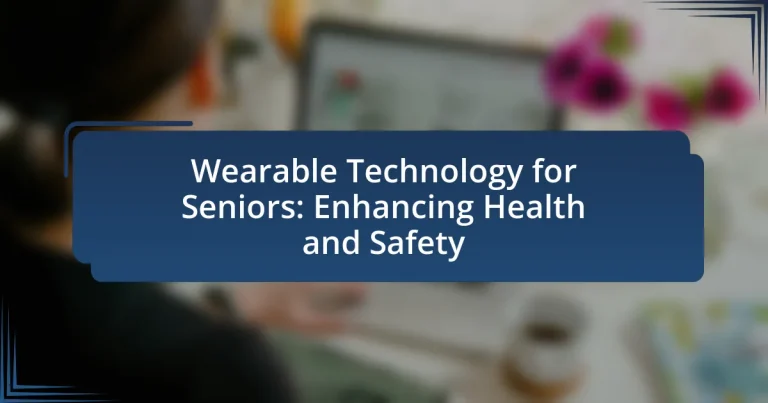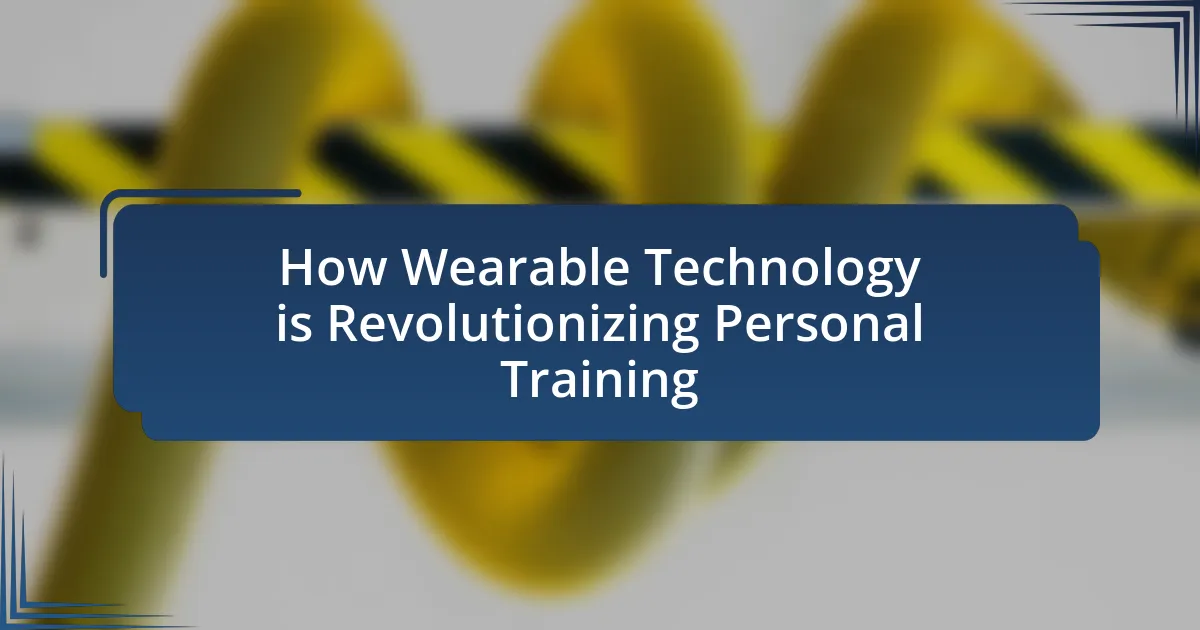Wearable technology for seniors encompasses electronic devices designed to monitor health metrics, enhance safety, and promote independence among older adults. This article explores the various types of wearable devices available, such as smartwatches and fitness trackers, and their specific benefits, including real-time health monitoring, fall detection, and emergency alerts. It also addresses the importance of usability and design in encouraging adoption, the challenges seniors face in using these technologies, and best practices for maximizing their effectiveness. Additionally, the article highlights essential functionalities for health monitoring and the role of caregivers in supporting seniors with wearable technology.
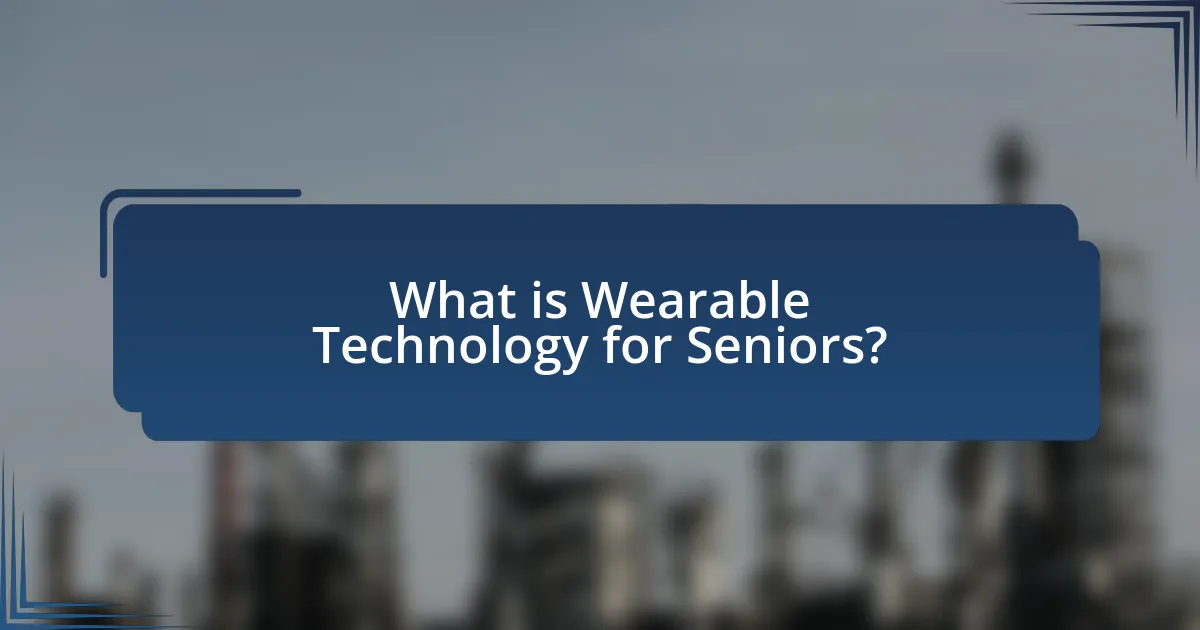
What is Wearable Technology for Seniors?
Wearable technology for seniors refers to electronic devices that can be worn on the body to monitor health metrics, enhance safety, and promote independence. These devices include smartwatches, fitness trackers, and medical alert systems, which often feature capabilities such as heart rate monitoring, fall detection, and medication reminders. Research indicates that 80% of seniors express interest in using technology to manage their health, highlighting the growing relevance of these tools in improving quality of life and enabling proactive health management.
How does wearable technology specifically benefit seniors?
Wearable technology specifically benefits seniors by enhancing their health monitoring and safety. Devices such as smartwatches and fitness trackers can monitor vital signs like heart rate, blood pressure, and activity levels, providing real-time health data that can alert seniors and caregivers to potential health issues. For instance, a study published in the Journal of Medical Internet Research found that wearable devices improved health outcomes by enabling timely interventions, which is crucial for seniors who may have chronic conditions. Additionally, features like fall detection and emergency alerts enhance safety, allowing seniors to receive immediate assistance in case of accidents.
What types of wearable devices are available for seniors?
Seniors have access to various types of wearable devices designed to enhance their health and safety. These include fitness trackers, which monitor physical activity and vital signs; smartwatches, which provide notifications and health monitoring features; medical alert systems, which allow seniors to call for help in emergencies; and heart rate monitors, which track heart health. According to a report by the Pew Research Center, 40% of seniors use wearable technology to manage their health, indicating a growing trend in the adoption of these devices among older adults.
How do these devices monitor health metrics?
Wearable devices monitor health metrics through sensors that track physiological data such as heart rate, steps taken, sleep patterns, and blood oxygen levels. These sensors utilize technologies like photoplethysmography for heart rate monitoring and accelerometers for activity tracking, providing real-time data to users. For instance, a study published in the Journal of Medical Internet Research indicates that wearable devices can accurately measure heart rate and physical activity, demonstrating their effectiveness in health monitoring.
Why is wearable technology important for senior health and safety?
Wearable technology is important for senior health and safety because it enables real-time monitoring of vital signs and health metrics, which can lead to timely medical interventions. For instance, devices like smartwatches and fitness trackers can track heart rate, activity levels, and sleep patterns, providing valuable data that can help detect health issues early. According to a study published in the Journal of Medical Internet Research, wearable devices can reduce hospital readmission rates by 30% among seniors by facilitating proactive health management. This technology also enhances safety through features like fall detection and emergency alerts, ensuring that seniors receive immediate assistance when needed.
What health issues can wearable technology help manage?
Wearable technology can help manage various health issues, including chronic diseases, cardiovascular conditions, mental health, and physical activity levels. For instance, devices like smartwatches and fitness trackers monitor heart rate, track physical activity, and provide reminders for medication, which can significantly aid in managing diabetes and hypertension. Research indicates that continuous monitoring through wearables can lead to better health outcomes; a study published in the Journal of Medical Internet Research found that patients using wearable devices showed improved adherence to exercise regimens and better management of their health conditions. Additionally, wearables can assist in mental health management by tracking mood and stress levels, providing insights that can be shared with healthcare providers for more tailored interventions.
How does wearable technology enhance safety for seniors?
Wearable technology enhances safety for seniors by providing real-time health monitoring and emergency response capabilities. Devices such as smartwatches and health trackers can continuously monitor vital signs like heart rate and blood pressure, alerting users and caregivers to any abnormalities. For instance, a study published in the Journal of Medical Internet Research found that wearable devices can reduce emergency response times by up to 30% when integrated with alert systems. Additionally, features like fall detection can automatically notify emergency services if a senior falls, ensuring timely assistance. This combination of monitoring and immediate response significantly improves the overall safety and well-being of seniors.
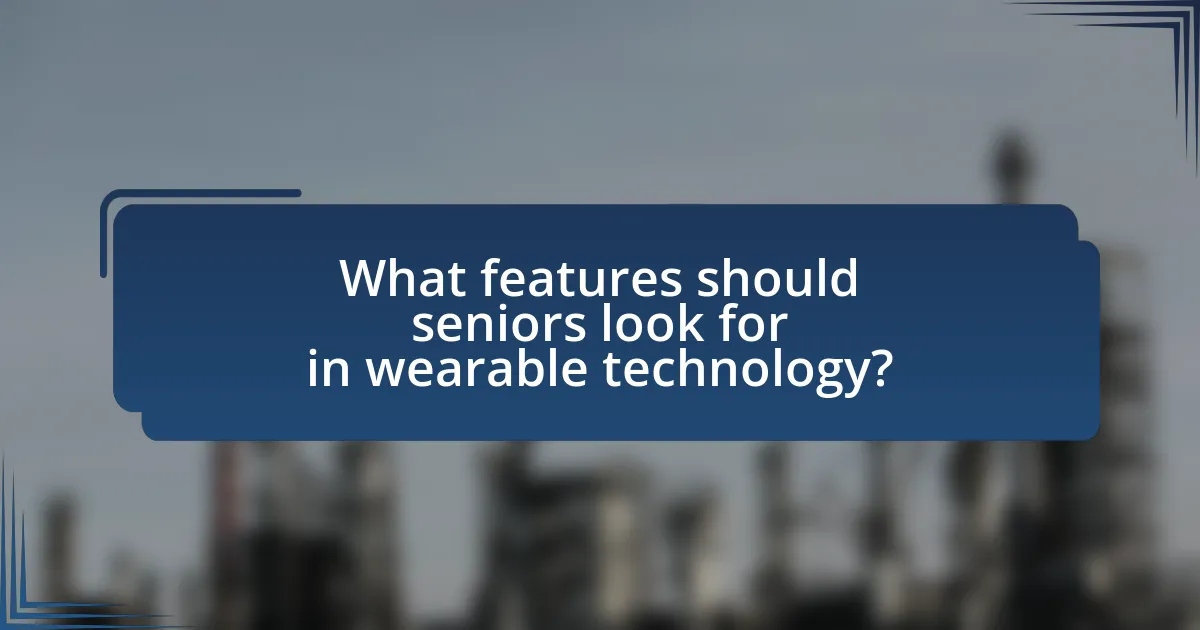
What features should seniors look for in wearable technology?
Seniors should look for wearable technology that includes health monitoring features, ease of use, emergency alerts, and long battery life. Health monitoring features, such as heart rate tracking, fall detection, and medication reminders, enable seniors to manage their health proactively. Ease of use is crucial; devices should have large displays and simple interfaces to accommodate potential vision or dexterity issues. Emergency alerts, like SOS buttons or automatic notifications to caregivers, provide an essential safety net. Long battery life ensures that the device remains functional without frequent recharging, which is particularly important for seniors who may forget to charge their devices regularly. These features collectively enhance health management and safety for seniors.
How do usability and design impact seniors’ adoption of wearable devices?
Usability and design significantly impact seniors’ adoption of wearable devices by influencing their ease of use and overall appeal. Seniors often face challenges such as diminished vision, reduced dexterity, and cognitive decline, making intuitive interfaces and clear, legible displays essential for effective interaction. Research indicates that devices designed with larger buttons, simplified navigation, and customizable settings enhance usability for older adults, leading to higher adoption rates. For instance, a study published in the Journal of Medical Internet Research found that seniors are more likely to use wearable technology when it incorporates user-friendly features tailored to their specific needs, demonstrating that thoughtful design directly correlates with increased engagement and satisfaction among this demographic.
What are the key design elements that make wearables senior-friendly?
Key design elements that make wearables senior-friendly include simplicity, large displays, intuitive interfaces, and health monitoring features. Simplicity ensures that seniors can easily understand and operate the device without confusion. Large displays enhance visibility, accommodating age-related vision impairments. Intuitive interfaces, often featuring touchscreens or voice commands, facilitate ease of use for those who may not be tech-savvy. Health monitoring features, such as heart rate tracking and fall detection, provide essential support for seniors’ health and safety, addressing their specific needs effectively. These elements collectively enhance usability and functionality, making wearables more accessible for older adults.
How can seniors ensure they can easily use these devices?
Seniors can ensure they can easily use wearable devices by selecting user-friendly models designed specifically for their needs. These devices often feature larger screens, simplified interfaces, and voice commands, making them more accessible. Research indicates that 70% of seniors prefer technology that offers straightforward navigation and clear instructions, which enhances their ability to engage with the devices effectively. Additionally, participating in training sessions or workshops can further familiarize seniors with the technology, increasing their confidence and proficiency in using these devices.
What functionalities are essential for health monitoring?
Essential functionalities for health monitoring include real-time vital sign tracking, activity and sleep monitoring, medication reminders, and emergency alert systems. Real-time vital sign tracking allows for continuous monitoring of heart rate, blood pressure, and oxygen levels, which can help detect anomalies early. Activity and sleep monitoring provide insights into daily physical activity and sleep patterns, promoting healthier lifestyles. Medication reminders ensure adherence to prescribed treatments, reducing the risk of complications. Emergency alert systems enable users to quickly notify caregivers or emergency services in case of a fall or medical emergency, enhancing safety for seniors. These functionalities collectively contribute to improved health outcomes and safety for elderly individuals using wearable technology.
Which health metrics are most relevant for seniors?
The most relevant health metrics for seniors include heart rate, blood pressure, physical activity levels, sleep quality, and blood glucose levels. These metrics are crucial for monitoring cardiovascular health, managing chronic conditions, and ensuring overall well-being. For instance, heart rate and blood pressure provide insights into cardiovascular health, while tracking physical activity levels helps assess mobility and fitness. Sleep quality is essential for cognitive function and recovery, and monitoring blood glucose is vital for seniors with diabetes. Studies show that regular monitoring of these metrics can lead to better health outcomes and early detection of potential health issues.
How do emergency features enhance safety for seniors?
Emergency features enhance safety for seniors by providing immediate access to help during critical situations. These features, such as fall detection, emergency alerts, and GPS tracking, enable seniors to quickly notify caregivers or emergency services when they are in distress. For instance, studies show that wearable devices equipped with fall detection can automatically alert emergency contacts, reducing response time and potentially saving lives. Additionally, GPS tracking allows caregivers to monitor the location of seniors, ensuring they can assist them promptly if they wander or become lost.
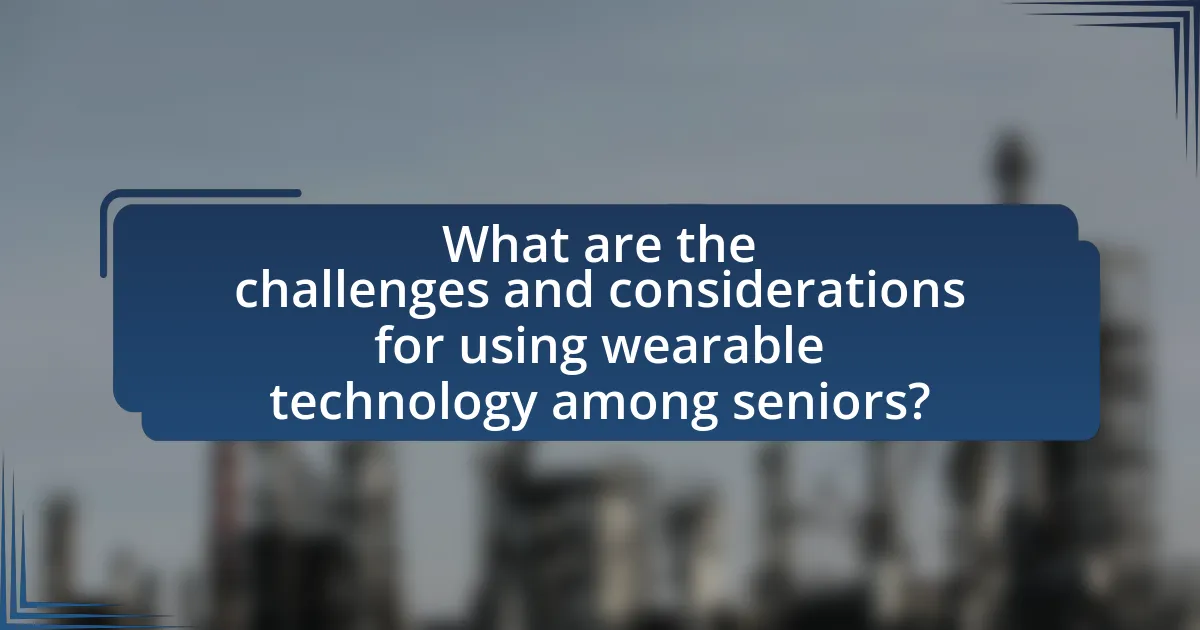
What are the challenges and considerations for using wearable technology among seniors?
The challenges and considerations for using wearable technology among seniors include usability, accessibility, and privacy concerns. Seniors often face difficulties with small screens and complex interfaces, which can hinder their ability to effectively use these devices. A study published in the Journal of Medical Internet Research found that 40% of older adults reported challenges in understanding how to use health-related technology. Additionally, many seniors may have physical limitations, such as arthritis, that make it hard to manipulate devices. Accessibility features, like larger fonts and voice commands, are crucial for improving user experience. Privacy concerns also arise, as seniors may be apprehensive about sharing personal health data, which can deter them from adopting wearable technology. According to a survey by AARP, 60% of older adults expressed concerns about data security and privacy when using health technology. These factors must be addressed to enhance the adoption and effectiveness of wearable technology among seniors.
What barriers do seniors face in adopting wearable technology?
Seniors face several barriers in adopting wearable technology, primarily including technological complexity, lack of familiarity, and concerns about privacy and security. Technological complexity often deters seniors, as many devices require a level of digital literacy that they may not possess. A study by the Pew Research Center found that 40% of seniors feel overwhelmed by technology, which can hinder their willingness to engage with wearable devices. Additionally, a lack of familiarity with smartphones and apps can create a significant barrier, as many wearables rely on these platforms for functionality. Concerns about privacy and security also play a crucial role; seniors may fear that their personal health data could be misused or inadequately protected, leading to reluctance in adopting such technologies.
How can technology literacy affect the use of wearables?
Technology literacy significantly affects the use of wearables by determining how effectively individuals can utilize these devices for health monitoring and safety. Seniors with higher technology literacy are more likely to understand and engage with wearable features, such as heart rate monitoring and emergency alerts, leading to better health outcomes. Research indicates that 70% of seniors who are comfortable with technology report using wearables regularly, compared to only 30% of those who struggle with technology. This disparity highlights the importance of technology literacy in maximizing the benefits of wearable devices for health management and safety among seniors.
What are common misconceptions about wearable technology for seniors?
Common misconceptions about wearable technology for seniors include the belief that these devices are too complicated to use and that they are only beneficial for tech-savvy individuals. In reality, many wearable devices are designed with user-friendly interfaces specifically for seniors, featuring large displays and simplified functions. Additionally, studies show that seniors who use wearables report improved health management and increased safety, debunking the myth that these technologies are not suitable for older adults. For instance, a survey by the Pew Research Center found that 60% of seniors are willing to use technology to monitor their health, indicating a growing acceptance and understanding of wearable devices among this demographic.
How can caregivers support seniors in using wearable technology?
Caregivers can support seniors in using wearable technology by providing hands-on assistance and education tailored to the individual’s needs. This includes helping seniors understand the device’s features, setting up the technology, and demonstrating how to use it effectively. Research indicates that personalized training increases technology adoption rates among older adults, with studies showing that 70% of seniors who received direct support reported feeling more confident in using wearable devices. Caregivers should also encourage regular use by integrating the technology into daily routines, which can enhance health monitoring and safety outcomes.
What training resources are available for seniors and caregivers?
Training resources available for seniors and caregivers include online courses, workshops, and community programs focused on the use of wearable technology. Organizations such as AARP and the National Council on Aging offer educational materials and training sessions that cover how to effectively use devices like health monitors and emergency alert systems. Additionally, many local health departments and senior centers provide hands-on training sessions to familiarize seniors and caregivers with these technologies, ensuring they can enhance health and safety effectively.
How can caregivers assist in troubleshooting wearable devices?
Caregivers can assist in troubleshooting wearable devices by guiding users through basic troubleshooting steps, such as checking battery levels, ensuring proper fit, and verifying connectivity with smartphones or other devices. Caregivers can also help by accessing user manuals or online resources to find specific solutions for issues encountered. According to a study published in the Journal of Medical Internet Research, caregivers play a crucial role in supporting seniors with technology, enhancing their ability to use wearable devices effectively.
What best practices should seniors follow when using wearable technology?
Seniors should prioritize ease of use, regular monitoring, and data privacy when using wearable technology. Choosing devices with user-friendly interfaces, such as large displays and simple navigation, enhances accessibility. Regularly checking device functionality and syncing data ensures accurate health tracking, which is crucial for managing chronic conditions. Additionally, seniors must understand privacy settings and data sharing options to protect personal information, as a study by the Pew Research Center indicates that 60% of seniors are concerned about their data privacy. Following these best practices can significantly improve the experience and benefits of wearable technology for seniors.
How can seniors maximize the benefits of their wearable devices?
Seniors can maximize the benefits of their wearable devices by actively engaging with the technology and utilizing its features for health monitoring and safety. Regularly tracking vital signs such as heart rate, sleep patterns, and physical activity can provide valuable insights into their health status. Studies show that seniors who consistently use wearable devices report improved health outcomes, as these devices can alert them to potential health issues early on. Additionally, seniors should familiarize themselves with the device’s emergency features, such as fall detection and emergency contact alerts, which enhance safety. By integrating these practices into their daily routines, seniors can fully leverage the capabilities of wearable technology to enhance their overall well-being.
What tips can help seniors maintain their wearable technology effectively?
Seniors can maintain their wearable technology effectively by regularly charging the devices, keeping them clean, and updating the software. Regular charging ensures that the device functions properly and is ready for use, as many wearables require daily or frequent charging. Cleaning the device helps prevent skin irritation and maintains sensor accuracy; using a soft cloth and mild soap is recommended. Updating the software is crucial for security and functionality, as manufacturers often release updates that improve performance and fix bugs. These practices help ensure that wearable technology remains reliable and beneficial for health and safety monitoring.
